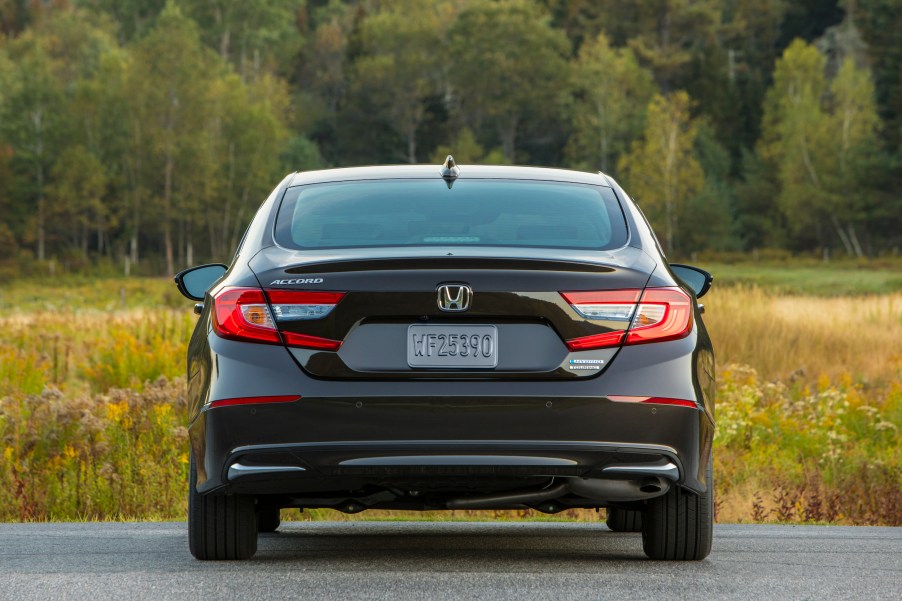
5 Midsize Cars With the Most Cargo Space Behind the Backseat
Driving a large SUV or van provides the most cargo space afforded by any passenger vehicle, but these behemoths take up a lot of real estate on city streets, and finding a parking space for them is often tricky. More often, families turn to midsize cars for their daily transportation so finding relatively small cars with the most cargo space is a bonus. Automakers publish vehicle specifications for their cars, including available cargo for each model, but are those numbers accurate?
How do car brands measure cargo space?
No one is accusing any automaker of trying to inflate their cargo space measurements. Automakers follow guidelines established by the Society of Automotive Engineers (SAE) and their internal procedures for obtaining cargo space values. These numbers generally derive from the computer-aided drafting (CAD) software used to design the vehicle in the first place.
Differences arise between automakers with inconsistent measurement points. For example, suppose one automaker uses the top of the rear seatback as the highest point for loading cargo in a hatchback, and another uses the top of the roof. In that case, the cargo space values vary widely, but there may not be any physical difference.
Cars.com aims to standardize the cargo space measuring process by using the same reference points and procedures across all brands in their testing and reporting. Cars.com isn’t sharing all the particulars of their approach, but generally, they measure from the floor to the top of the trunk lid or top of seatbacks in open cargo space vehicles, the width and length of the cargo space to achieve a volume measurement. They also account for variations within the area, such as sloping floors, moving seats to their farthest rear position, and reclining seatbacks to a standard angle.
Comparing Cars.com to automaker’s cargo space values
While the Cars.com article cautions against comparing its cargo space values to those supplied by an automaker, it is interesting to see the differences. We’ll compare the measurements for a few select vehicles.
Mercedes-Benz E-Class wagon
The 2022 Mercedes-Benz E-Class E450 All-Terrain wagon features a turbocharged 3.0-liter inline six-cylinder engine that makes 362 horsepower, up to 28 MPG on the highway, and a starting price of $68,400. In addition, Mercedes-Benz reports 35 cubic feet of cargo capacity behind the rear seat. In contrast, the Cars.com team measured the cargo space behind the 2022 Mercedes-Benz E-Class E450 All-Terrain wagon back seat and found 21.1 cubic feet.
Tesla Model S
The 2022 Tesla Model S Plaid EV features an all-electric drivetrain capable of blistering acceleration, up to 200 mph top speed, and a starting of $135,990. Tesla lists the Model S Plaid at cargo space at 28 cubic feet, but Cars.com calculated it at 20.9 cubic feet.
Kia K5
The 2021 Kia K5 EX started at $28,090 and featured a 1.6-liter turbocharged four-cylinder producing 180 horsepower and a full suite of driver assist safety features. Kia estimated the K5’s cargo space at 16 cubic feet, but Cars.com found 20.3 cubic feet behind the rear seat.
Honda Accord Hybrid

The 2021 Honda Accord Hybrid Touring featured up to 43 MPG combined with seating for five and a starting price of $36.240. Honda reports the Accord Hybrid Touring’s cargo space at 16.7 cubic feet, but the Cars.com team found additional space at 19.9 cubic feet.
Hyundai Sonata
The 2021 Hyundai Sonata Limited had a starting price of $33,950 and featured a 180 horsepower 1.6-liter inline-four-cylinder engine with a fuel economy rating of up to 37 MPG on the highway. Cars.com lists the cargo space behind the rear seat at 19.8 cubic feet, but Hyundai reports cargo space at 16 cubic feet.
Which midsize car with the most cargo space should you buy?
The 2022 Mercedes-Benz E-Class E450 All-Terrain wagon has the most cargo space but, except for the Tesla Model S Plaid, has the highest price of any model on our list. On the other hand, the Kia K5 EX, with its low price point, driver assist safety features, and cargo space near the E450 All-Terrain wagon, deserves consideration for a midsize family car. However, the Tesla Model S Plaid is the best choice if your 20.9 cubic feet of cargo needs to be someplace fast.



